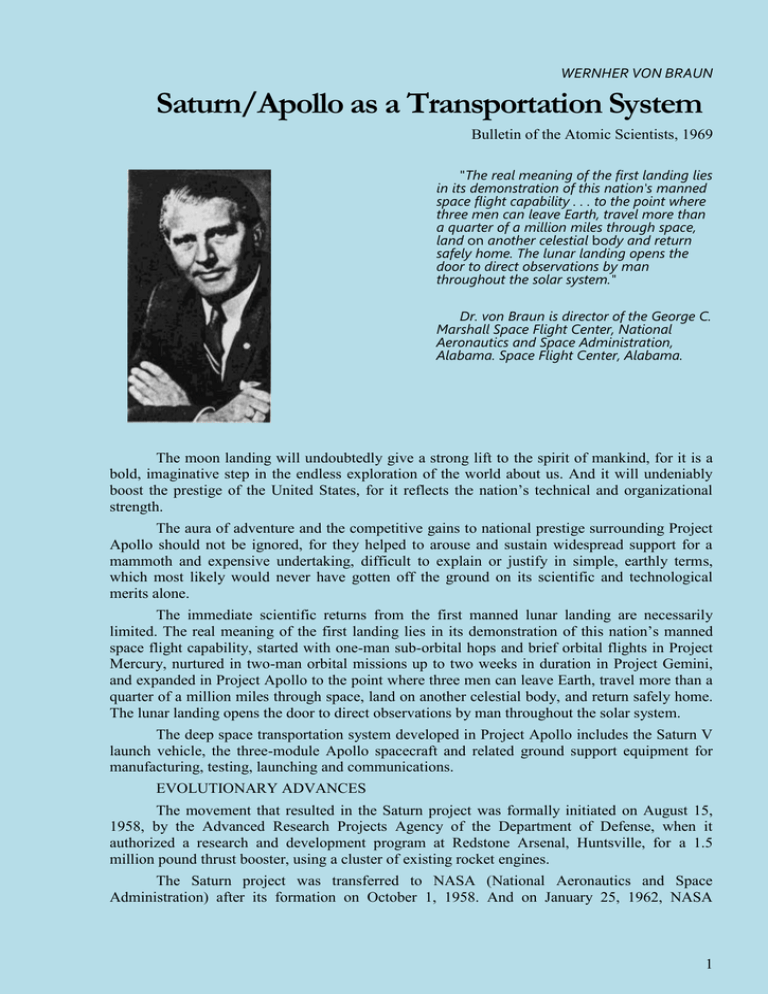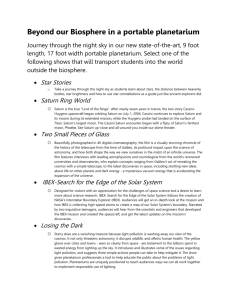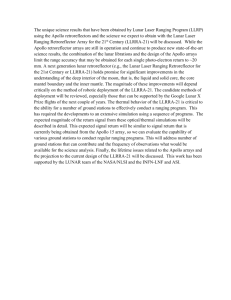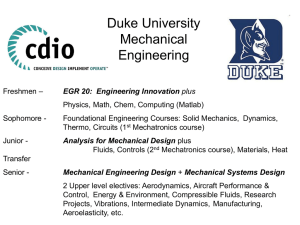Saturn/Apollo as a Transportation System
advertisement

WERNHER VON BRAUN Saturn/Apollo as a Transportation System Bulletin of the Atomic Scientists, 1969 "The real meaning of the first landing lies in its demonstration of this nation's manned space flight capability . . . to the point where three men can leave Earth, travel more than a quarter of a million miles through space, land on another celestial body and return safely home. The lunar landing opens the door to direct observations by man throughout the solar system." Dr. von Braun is director of the George C. Marshall Space Flight Center, National Aeronautics and Space Administration, Alabama. Space Flight Center, Alabama. The moon landing will undoubtedly give a strong lift to the spirit of mankind, for it is a bold, imaginative step in the endless exploration of the world about us. And it will undeniably boost the prestige of the United States, for it reflects the nation’s technical and organizational strength. The aura of adventure and the competitive gains to national prestige surrounding Project Apollo should not be ignored, for they helped to arouse and sustain widespread support for a mammoth and expensive undertaking, difficult to explain or justify in simple, earthly terms, which most likely would never have gotten off the ground on its scientific and technological merits alone. The immediate scientific returns from the first manned lunar landing are necessarily limited. The real meaning of the first landing lies in its demonstration of this nation’s manned space flight capability, started with one-man sub-orbital hops and brief orbital flights in Project Mercury, nurtured in two-man orbital missions up to two weeks in duration in Project Gemini, and expanded in Project Apollo to the point where three men can leave Earth, travel more than a quarter of a million miles through space, land on another celestial body, and return safely home. The lunar landing opens the door to direct observations by man throughout the solar system. The deep space transportation system developed in Project Apollo includes the Saturn V launch vehicle, the three-module Apollo spacecraft and related ground support equipment for manufacturing, testing, launching and communications. EVOLUTIONARY ADVANCES The movement that resulted in the Saturn project was formally initiated on August 15, 1958, by the Advanced Research Projects Agency of the Department of Defense, when it authorized a research and development program at Redstone Arsenal, Huntsville, for a 1.5 million pound thrust booster, using a cluster of existing rocket engines. The Saturn project was transferred to NASA (National Aeronautics and Space Administration) after its formation on October 1, 1958. And on January 25, 1962, NASA 1 approved developments of the three-stage Saturn V for manned circumlunar flights and manned landings using the lunar orbital rendezvous method. It was originally estimated that the Apollo spacecraft would weight 45 or more tons. Starting with this mission requirement, we designed and built the Saturn V to place 140 tons into low Earth orbit or send 50 tons to the vicinity of the moon. For 10 years we have been concentrating much of our effort on developing this ability to place men and X number of роunds of payload into space. Now that this capability has been demonstrated satisfactorily, we can give more attention to its beneficial use. No one knows what the final destiny of man in space will be, or if there will indeed be any limit to his explorations. Regardless of where the trail blazed by Apollo leads us, I am convinced that man’s first footprint on the moon marks the beginning of a bright new era in space exploration. And I am just as certain that the advances of the future, like those of the past, will be entirely evolutionary, as we continually apply hard-won knowledge and experience to the solution of fresh and intriguing mysteries. LIMITED FIRST MISSION During the first lunar landing mission the astronauts were to remain on the moon’s surface for less than one day. The time spent outside their lunar module was to be limited to two hours and 40 minutes, and they were not to venture more than 50 feet from their spacecraft. Since the primary purpose of this mission was to demonstrate an operational capability, а conservative approach was adopted. The primary scientific objective of the first landing was to collect up to 80 pounds of lunar samples, for analysis by scientific investigators from 20 institutions in eight countries. The two men also were to emplace simple equipment for three scientific experiments — a solarpowered seismometer for detecting moonquakes, an aluminum-foil detector for solar wind particles and a multi-piece glass mirror to reflect the light of ruby lasers mounted in telescopes on earth. Astronomers of all nations will be able to direct their telescopes at the laser retroreflector which will enable them to earth-moon distances to an accuracy six inches in 250,000 miles. Its use should increase our knowledge of the moon’s size and shape, movement of the Earth’s poles and possible drift of the continents. The moon itself is a poor reflector, with an albedo of about 11 per cent. In addition, live television pictures lunar features and astronaut activity were to be transmitted to Earth, hopefully in color, as well as movies of the landing, activities of the astronauts on the surface, and ascent from the moon. 2 Space voyager, conceived in 1815 by E. F. Burney, was equipped with oxygen, a barrel of provisions and a motometer, and shot into the stratosphere by three cannons pointed skywards. FUTURE MISSIONS NASA has plans ready for implementing a logical phasing of lunar exploration missions after the first lander. The first phase of continued exploration would use immediately available Saturn V launch vehicles, Apollo spacecraft and facilities funded by Apollo for investigating the two types a lowlands or maria and the two major classes of highlands. The second phase would involve flights to more difficult sites, requiring pinpoint landing accuracy, increased mobility, longer staytime and greater payloads. The third phase would consist of orbital missions, using remote instruments aboard the command service modules to study the lunar surface. And then one can envision the buildup of exploration capability by revisiting the same site on the moon, this is turn might lead to semi permanent and eventually permanent operation of a lunar base, complete with observatory and research facilities. The eastern maria of the moon, which have a barely reddish tinge, are distinctly different from the western maria which are slightly bluish in appearance. During the first follow-on missions the astronauts would emplace а more complex set of devices, called Lunar Surface Experiment packages, each with a nuclear isotope power supply that would permit operation for one to two years. NASA’s budget requests for fiscal year 1970 include the continuation of Apollo lunar missions at the rate of two or three flights a year. Lunar Orbiter, Surveyor and Apollo photographs have identified many additional interesting landing sites, such as volcanic types, riverlike channel-ways, fracture zones and impact craters. INCREASING CAPABILITY The capability of the basic Apollo system must be increased to permit exploration of these additional sites. The first requirements are improved astronaut mobility, longer staytimes on the surface and expanded instrumentation. 3 Astronaut mobility can be advanced by the use of a constant-volume suit which would reduce the amount of energy expended by the astronaut in moving about. Improvements in joint design would incorporate rotary bearings, rolling convolutes and constant-volume bellows. A new suit would not be an entirely new development effort, for much of the existing technology in materials, thermal meteroid garment layup, helmets, visor assembly and connectors would be used. The current portable life support system weighs 120 pounds on Earth, but only 20 pounds on the moon. As the space suit is improved, such things as an additional battery and water tank can be added to the life-support system to enable the astronauts to remain outside the lunar module for longer periods. While the current lunar module can remain on the moon’s surface for about 36 hours, the initial missions are planned for less than 24 hours. One reason for this is the fatigue limitations of the astronauts, who will have just completed a three-day trip from Earth under less than ideal conditions, and who will face a long journey home. Lunar module staytime can be increased to three days by including additional water and oxygen tanks, batteries, crew provisions, enlarging the descent propellant tank, and making the crowded quarters more habitable. Since there are no beds, couches, or even chairs in the lunar module, sleeping is difficult. While the lunar module is on the moon’s surface, the command and service module remains overhead in lunar orbit. Some modifications to the basic command and service module would also be required for longer duration missions. DUAL LAUNCHES Studies now underway for even more ambitious lunar exploration envision dual launches of the Saturn V. The first launch would place an unmanned payload on the moon and the astronauts would arrive later after launching by a second Saturn V. Since we would not need to provide for liftoff from the moon for the unmanned payload, we could land an extremely large cargo on the lunar surface. We could provide a shelter for the astronauts, stocked with enough supplies and equipment to sustain a group of explorers for many months. And we could even provide a lunar flying unit, roving surface vehicle, drilling equipment and other items that would permit more extensive geological research. A lunar flying unit would provide not only greater range of travel over the lunar surface, but would permit vertical mobility for exploration of crater walls and steep terrain. Another mobility aid under active study is the surface roving vehicle. Using heavy-duty batteries for electrical power, the rover would carry one astronaut over the lunar surface at a top speed of about nine miles an hour on short excursions from the shelter. REMOTE CONTROL Before the astronauts leave the moon, they would set the roving vehicle’s controls in the mode for remote control from Earth. The remote controlled mode of the roving vehicle will require a radioisotope thermoelectric generator (RTG) for recharging the batteries at regular intervals. The nuclear power supply will be similar to the low wattage “SNAP” units presently being developed for space use. An important consideration will be to use the normally wasted heat associated with the generator for thermal control of the electrical components during lunar night. By allowing sufficient recharge time and selecting a long half-life isotope (PU-238), the roving vehicle can be operated for an extended period of time with a minimum weight and volume for the total power supply sub-system. By using its television camera and other instrumentation, Earth-based controllers could send the vehicle on automated geological and geophysical trips of more than 500 miles, lasting about one year. During its travels the rover would make scientific measurements of different 4 types of lunar terrain and collect up to 200 pounds of lunar samples. Then it would rendezvous with a manned spacecraft. The crew would transfer the samples to the lunar module, and return them to Earth for analysis. Lunar exploration interests the scientific community in its search for greater knowledge of the origin and history of the moon and its relation to the Earth and to the solar system. It is also important for learning more about the capabilities and limitations of man as a space explorer. The moon will be a training ground, from which man will some day move on to explore other planets. Continued exploration will determine the feasibility of the moon as a base for an observatory or a permanent science station, and the possibility of using it as a launch platform or refueling station for planetary exploration. This latter scheme may not appear, very attractive at the moment; however, should water be found on the moon, as either permafrost or crystal water, its prospects would brighten. Should a nuclear reactor be emplaced on the moon in support of lunar surface operations, making possible the conversion of any available water into hydrogen and oxygen by electrolysis, then refueling on the moon for interplanetary voyages may indeed offer advantages. If our current manned space flight continues to evolve, manned planetary exploration would be feasible during the 1980s. While it will not be necessary to make a firm commitment toward such an objective for several years, the option should be kept open by continuation of unmanned investigations of the planets and the initiation of a large space station program. No significant modifications to the Saturn V launch vehicle will be necessary to achieve the early lunar objectives. The trans-lunar injection payload capability can be increased 10 per cent by rather nominal first-generation modifications which Marshall Space Flight Center personnel have been considering for some time. Later on, however, the capability of the Saturn V will need to be increased substantially by such means as strap on solid rocket motors to the first stage. While this approach would give us greater payloads to Earth orbit, we would still need improvements to the upper stages for propelling large payloads to escape velocity. The most effective way for improving the capability of the Saturn V for these distant missions is the addition of а nuclear third stage. The feasibility and the high performance potential of the nuclear rocket propulsion system have been thoroughly demonstrated in the extensive series of successful reactor and breadboard engine system tests conducted jointly by NASA and Atomic Energy Commission at the Nuclear Rocket Development Station in Nevada. The escape payload capability of the Saturn V would be approximately doubled by the substitution of a nuclear third stage for the S-IVB stage new used, which burns liquid hydrogen and liquid oxygen in a single J-2 engine to produce 200,000 pounds of thrust. Furthermore, studies indicate that there would be no major problem in the integration of the nuclear stage with the Saturn V launch vehicle itself or with the launch facilities at the Kennedy Space Flight Center. INMANNED PROBE Development of a nuclear stage it only provide a major advancement in space propulsion capability but it would give needed flexibility to mission planning. Take an inmanned probe to Jupiter, for example. With a nuclear upper stage for a Saturn V, as compared to a chemical would have the alternative it sending two or more spacecraft, thereby increasing the probability of mission success; sending a larger single spacecraft; or significantly reducing the duration of the mission. The reduce intrip time is perhaps more important than meets the eye. A 50 percent reduction in mission duration, with would be possible, would mean reduced operating time requirements for the spacecraft, ground systems, and the people supporting the mission. 5 The suggested Grand Tour unmanned probe of the planets Jupiter, Saturn, Uranus and Neptune would specially benefit by the use of a nuclear stage. For instance, a Saturn V with a nuclear upper stage could offer a Grand Tour scientific payload of about 40,000 pounds, which would permit individual probes or orbiters to the various planets as the spacecraft flies by. This does not appear possible with chemical rocket propulsion only. A nuclear stage would also open up the launch windows. We are fairly tell limited to the 1977-78 window with all-chemical Saturn V, whereby a nuclear third stage would permit flight the 1976 to 1980 time period. A nuclear stage may also prove quite useful for lunar logistics and Earth orbital maneuvering and ferry-type missions. Such possible applications we under study at the Marshall Center. Manned space flight activities in the immediate post-Apollo period will involve the use of a Saturn launch vehicle upper stage as a Workshop, the progenitor of a large space station. The 10,000-cubic-foot liquid hydrogen tank of an S-IVB stage, launched into orbit, will be outfitted as a base where astronauts will perform experiments and make observations during missions of 28 and 56 days. An important part of the 56-day mission, scheduled for 1972, will be the linking to the Workshop of a large solar telescope and other instruments for direct observations of the sun. NASA has been studying progressively larger space stations for several years. On the basis of these studies, we are moving to bypass the intermediate space station, launch vehicles and logistic craft, and go directly into the design of a large semi-permanent manned space station and a logistic system for lowering costs by as large a factor as possible. Contracts for definition of the space station and the low-cost transportation system were let this spring. INITIAL LAUNCH The station would be built 200 to 300 miles above the Earth by assembling prefabricated modules launched separately into orbit. The initial launch could be manned by a crew of perhaps 12 men. Operations would begin immediately to accomplish many of the fundamental objectives of manned space flight. By the gradual addition of other modules, the station could accommodate a crew of perhaps 50 men by 1980. The station would be planned for 10 years of continuous operation. This would require high reliability subsystems design as well as provisions for maintenance, repair, refurbishment, replacement of parts and replacement of expendables. Electric power would come from solar panels or a small nuclear generator. There are many advantages connected with a space station large enough to contain both laboratory and observatory capabilities. First, its very size connotes a capability for tremendous electrical power, computation, and data-handling capacity. Further, as we increase the number of men aboard a space station, we get a far better relationship between the experimenters and the operators of the station. In a small base, much of the crew time is required just to operate the station. As the station gets larger, however, the number of occupants who can perform useful experimental work increases rapidly, while the number of operators does not climb as fast. SPACE WAREHOUSE Another advantage of a large base is its ability to serve as a warehouse in space. Such a storage place for spare parts, food, materials and equipment would permit continuous operations for long periods of time without resupply, similar to the Antarctica scientific stations. Another asset of the large station would be its long lifetime. Long duration plus intensity operations are necessary for amortizing the high initial costs over the total returns. Now, what are some of the problems related to a large station? First, there is the question of long lifetime for the basic systems. How are you to provide long-lasting equipment without incurring costs of testing and qualification so exorbitant as to make the whole project uneconomical? The approach of accelerated testing may help to solve this problem. And too, we 6 should not overlook the importance of using man’s capabilities. The system should be maintainable by man. This is the maintenance concept used here on Earth; now we must learn to apply it to space activities. Another uncertainty still plagues us with regard to the artificial versus zero gravity requirements. Artificial gravity could be provided by a rotating ward room and experiment facility. The activities planned for the 28- and 56- day Workshop missions will give us revealing insight into more facets of manned operations in zero gravity. Other crucial areas in the operation of a large space station would be time sharing in flight, radio frequency interference and related inter-actions, and the problems of mechanical couplings, vibration, orientation and translation between different experiments and operations. Saturn/Apollo on the launch pad. The crew of a space station would need to be rotated at three - to six-month intervals, and new experiment packages and modules would be brought up as they became available and could be accommodated by the station workload. A low-cost transportation system is a must if the operating costs of the manned space laboratories and observatories are to be reduced to a level that would permit their extensive exploitation for scientific, technological and economic purposes. As long as we launch a vehicle once and discard it in the Atlantic, the process will be expensive. The launch vehicle must be re-usable if costs are to be reduced drastically. NASA is performing studies for a re-usable shuttle that would ferry men and materials between the station and Earth. It would be launched vertically, shed supplementary fuel tanks in flight and land horizontally on a runway adjacent to the launch site. The exact size of such a shuttle has not been determined, but to accommodate a 30- to 50-man station, it should probably carry from 12 to 15 men. In addition, it should carry a considerable amount of cargo, probably 20,000 pounds. If we could manage to transport passengers and cargo into Earth orbit for anywhere between $50 and $10 per pound, the space station would become attractive to a large number of users. In the fields of basic science and basic research, the space station would be valuable in the areas of astronomy, the physics of fundamental particles, space biology, materials research 7 and many others. In the area of applications, it could contribute to the fields of communications, meteorology, and the observation and management of Earth’s resources. Several of these activities are already in progress using unmanned satellites, but man can have a useful and worthwhile role in the expansion of these programs in the future. Man in space can maintain and repair faulty equipment, replace sub-systems, change experiments and operate instruments as a scientist. I believe that the discoveries, the advances in technology, and the applications of knowledge which are within our reach during the post-Apollo period of space exploration will far exceed the achievements of our first decade in space, if we but resolve to use the space capability now on hand in a continuing evolutionary manner. OCR И.Моисеев, 10.05.2013. 8






